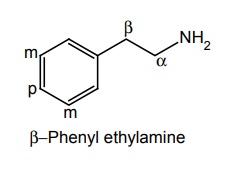Structure Activity Relationship
| Home | | Medicinal Chemistry |Chapter: Medicinal Chemistry : Adrenergic Drugs
Many of the sympathomimetic drugs contain β-phenyl ethylamine as parent structure.
STRUCTURAL-ACTIVITY RELATIONSHIP Many of the sympathomimetic drugs contain β-phenyl ethylamine as parent structure. Substitution on the meta and para positions of the aromatic ring and on the amino, α, and β positions of the ethylamine side chain influences the mechanism of sympathomimetic action and the receptor selectivity of the drug. Maximal activity is seen in β-phenyl ethylamine derivatives, containing hydroxyl groups in the meta and para positions of the aromatic ring (catechol) and a β-hydroxyl group of the correct stereo- chemical configuration on the ethylamine portion of the molecule. Although the catechol moiety is an important structural feature to obtain maximal agonistic activity at adrenergic receptors, it can be replaced with other substituted phenyl moieties to provide selective adrenergic agonism. • For example, replacement of the catechol function of isoproterenol with the resorcinol structure gives the drug metaproterenol, which is a selective β2-receptor agonist. • In an other approach, replacement of the meta hydroxyl of the catechol structure with a hydroxymethyl group afforded Salbutamol, which shows selectivity to the β2 receptor. • The naturally occurring noradrenaline has 3, 4-dihydroxy benzene ring (catechol) active at both α and β receptors. However, it has poor oral activity because it is rapidly metabolized by COMT, the change in substitution pattern 3, 5-dihydroxy as in metaproterenol gives good oral activity. This is due to its resistance to metabolism by COMT. It also provides selectivity for β2 receptors. • Amino group in phenylethylamines is important for direct agonistic activity. • The amino group should be separated from the aromatic ring by two carbon atoms found among the potent direct-acting agonists. • As the bulk of the nitrogen substituent increases, α-receptor agonistic activity decreases and β-receptor activity increases. Thus, NE that is an effective β -receptor agonist is also a potent α-agonist, while epinephrine is a potent agonist at α, β1, and β2 receptors. N-tertiary butyl group enhances β2 selectivity. As the size increases from hydrogen in noradrenaline to methyl in adrenaline, isopropyl in isoproterenol, the activity of α receptor decreases and β receptor increases. • Primary and secondary amines are more potent direct-acting agonists than 3° or 4° amines. • Methyl or ethyl substitution on the α-carbon of the ethylamine side chain reduces direct receptor agonist activity at both α and β receptors. • Importantly, an α-alkyl group increases the duration of action of the phenylethylamine agonist by making the compound resistant to metabolic deamination by MAO. • α-substitution also significantly affects receptor selectivity. • Another effect of α-substitution is the introduction of a chiral centre, which has pronounced effects on the stereo-chemical requirements for activity.
I. Phenyl ring substitution
II. Substitution at nitrogen
III. Substitution on the carbon side chain
Related Topics
